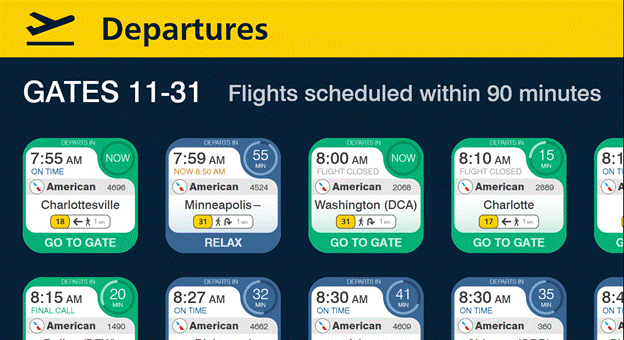By Colleen Hamilton, Principal, Art of Context
 Colleen Hamilton is a principal with Art of Context, a Boston-based technology firm helping airports improve passenger experience through innovative technology solutions that reduce client administration and ensure extension for future innovations. Art of Context has recently been certified as a DBE.
Colleen Hamilton is a principal with Art of Context, a Boston-based technology firm helping airports improve passenger experience through innovative technology solutions that reduce client administration and ensure extension for future innovations. Art of Context has recently been certified as a DBE.
The long-awaited expansion of Boston’s International gateway, Logan Airport Terminal E, has finally arrived, and with it, the next generation of airline operations and passenger experience. The project saw a significant expansion of the terminal that included a variety of improvements in energy efficiency, the use of more natural light, and a statement making façade complete with custom prismatic paint, a striking color known as Boston Red. The expanded terminal also adds four long-awaited gates.
As part of the team responsible for the evolution of the terminal, Art of Context worked with stakeholders to create and implement a boarding control app for Common Use gates. The interface is part of Art of Context’s Airport Display Platform (ADP). It is web-based with an intuitive interface driven by robust, secure technology. The app can be used from common use terminals or stand-alone on a tablet. It was rolled out terminal-wide in early August.
Customizing Common Use
 All of the gates in Terminal E are Common Use gates. ADP’s Sign Studio module drives the suite of displays that figure prominently in the boarding podium and within the gate pier. The ADP templates tie into both flight data and the boarding control app interface to display the correct complex scenario.
All of the gates in Terminal E are Common Use gates. ADP’s Sign Studio module drives the suite of displays that figure prominently in the boarding podium and within the gate pier. The ADP templates tie into both flight data and the boarding control app interface to display the correct complex scenario.
This template-driven approach provides consistency while also allowing airlines the freedom to customize messaging to accommodate their specific boarding practices.
From the Common Use terminal, agents log into an intuitive interface and can select necessary boarding groups (even boarding out of order if desired) and choose which doors are used. The signage within the gate pier adjusts for domestic or international arrivals or departures depending on whether travelers need passport control. If arriving travelers require customs clearance, signage directs them to the appropriate path. There are sign groups for international departures, domestic arrivals and international arrivals.
 The new gates are “swing gates”/”flex gates” They can accommodate one large wide body jet or the simultaneous boarding of two smaller planes. The process is data driven, so the signage will accommodate either scenario automatically.
The new gates are “swing gates”/”flex gates” They can accommodate one large wide body jet or the simultaneous boarding of two smaller planes. The process is data driven, so the signage will accommodate either scenario automatically.
Customs and Border Protection Compliance
 The system accommodates the CBP Biometric Facial Comparison technology. Upon login, the gate agent selects standard or biometric boarding. If biometric boarding is chosen, the boarding process instructions and privacy notices are displayed on a totem sign satisfying Customs and Border Protection mandates.
The system accommodates the CBP Biometric Facial Comparison technology. Upon login, the gate agent selects standard or biometric boarding. If biometric boarding is chosen, the boarding process instructions and privacy notices are displayed on a totem sign satisfying Customs and Border Protection mandates.
It’s a complex system, but, by taking the time to understand stakeholders’ needs, and combining that with our depth of experience, AOC excels at making the complex simple.
More than 43,000 international flights departed from Boston in 2022. This new process will allow airlines to customize the experience to their standards while providing an informative, expedient boarding process.
To learn more about how Art of Context can help you improve your passenger experience with Airport Display Platform please visit us at www.artofcontext.com
DISCLAIMER
This article was provided by a third party and, as such, the views expressed therein and/or presented are their own and may not represent or reflect the views of Airports Council International-North America (ACI-NA), its management, Board, or members. Readers should not act on the basis of any information contained in the blog without referring to applicable laws and regulations and/or without appropriate professional advice.


 Design template (example data). Leverage space on landscape screens without sacrificing display of flight information.
Design template (example data). Leverage space on landscape screens without sacrificing display of flight information.



 Colleen Hamilton is a principal with Art of Context, a Boston-based technology firm helping airports improve passenger experience through state-of-the-art technology solutions that reduce client administration and ensure extension for future innovations. Art of Context has recently been certified as a DBE.
Colleen Hamilton is a principal with Art of Context, a Boston-based technology firm helping airports improve passenger experience through state-of-the-art technology solutions that reduce client administration and ensure extension for future innovations. Art of Context has recently been certified as a DBE.